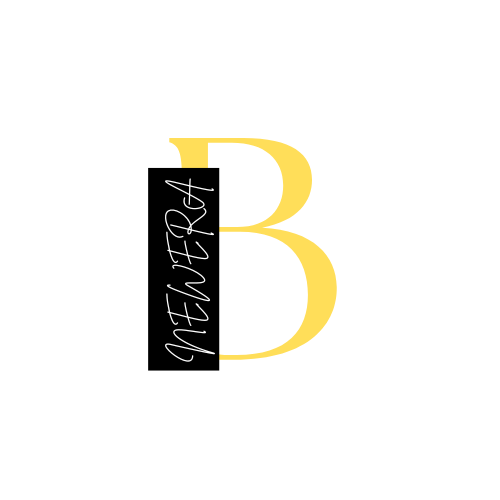AI and creativity might seem like opposites—until you see how artificial intelligence is secretly powering the world’s most iconic brands.
Did you know 92% of companies now use smart tools to improve their visual branding? These tools do more than just automate tasks. They change how businesses connect with their audience. If you want to make your brand stand out, combining old methods with new tech could be the key.
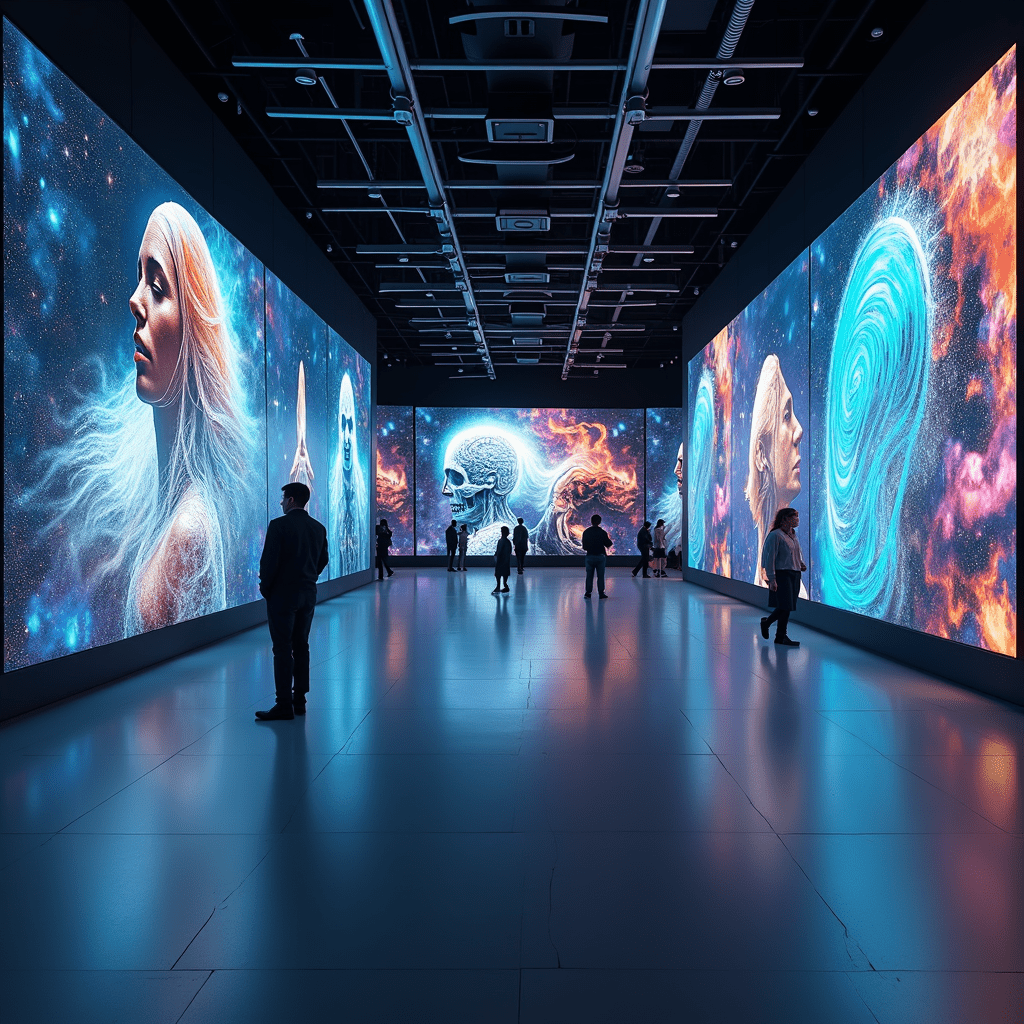
Today’s technology works like a creative partner, looking at trends and coming up with ideas fast. Imagine turning rough sketches into perfect logos or making designs fit what customers like—all in minutes. Advanced algorithms help you try out different colors, layouts, and styles while keeping your brand’s unique touch.
This isn’t about replacing your team’s talent. It’s about making it better. For example, one drink company used machine learning to create packaging that fit local tastes. This boosted sales by 34% in test areas. Whether it’s tweaking a slogan or redoing a website, these systems give you insights to sharpen your ideas.
Ready to see how art and innovation come together? Let’s look at ways to use these tools in your work without losing your brand’s essence.
Table of Contents
Key Takeaways
- Intelligent tools speed up design work while keeping it creative.
- Data insights help make visuals that fit what people like.
- Mixing old techniques with new tech makes brands stand out.
- Real examples show big improvements in how customers engage.
- There are steps to start using these tools without overwhelming your team.
- Staying ahead means embracing new ways to tell your brand’s story.
The Evolution of Creativity in the Digital Age
Designers used to work with ink and paper. Now, they use tablets and algorithms. This change isn’t about giving up old ways. It’s about making new things possible by mixing skill with digital precision.
From Traditional to Tech-Enhanced Artistry
Human creativity is the spark, and tech is the fuel. Designers used to spend hours on letterforms by hand. Now, tools look at millions of ads to suggest font pairings that connect with your audience. But the final choice is yours.
Many studios mix sketching with digital tweaks. A logo might start as pencil marks, then get refined through vector editing and data-driven color tests. This mix keeps the artistic intent while aiming for impact.
The Role of Data in Shaping Modern Design
Data isn’t just numbers—it shows what people like. Platforms track how people interact with visuals, showing patterns you can’t ignore. One fashion brand used heatmaps to change their website layout, doubling time spent on the site.
These insights help refine your work without losing originality. For example, strategic branding services might mix mood board making with A/B testing. This ensures designs feel personal yet work well.
The trick? Let data guide, not control. Your vision is key, and tech does the hard work.
AI as a Creative Ally in Modern Branding
Imagine your next big branding idea coming from an unexpected source. Research shows machine learning tools come up with 42% more ideas than old brainstorming methods. These systems are like digital muses, giving you new angles while you guide the direction.
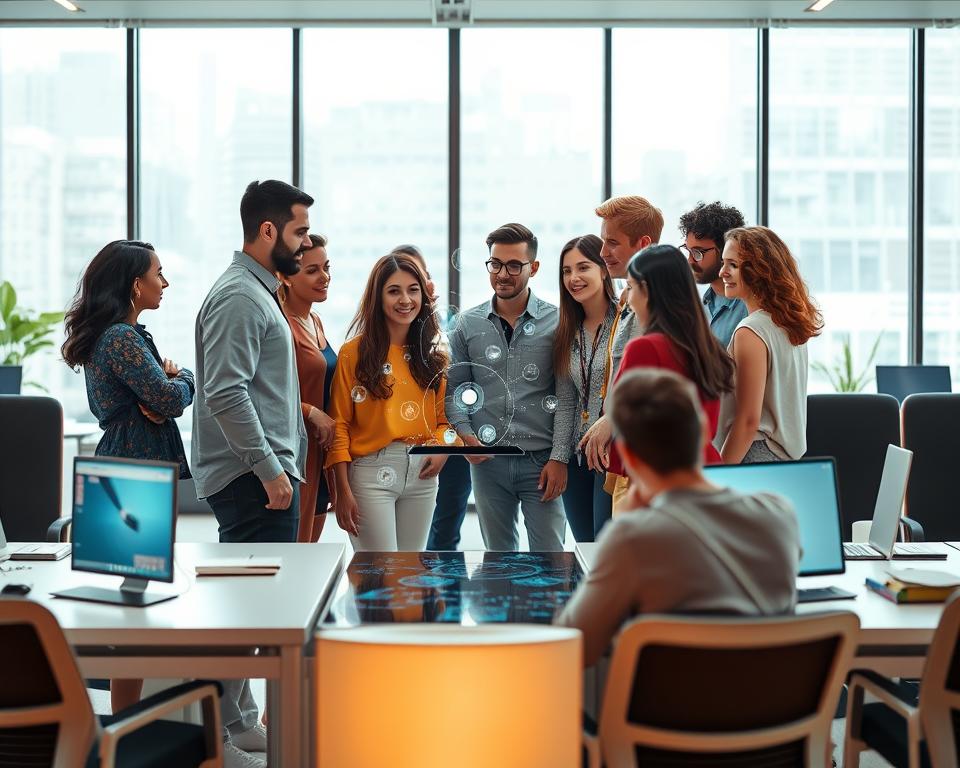
Generating Inspiration and Fresh Ideas
Feeling stuck? Intelligent platforms look at successful campaigns to suggest ideas. They offer color palettes, taglines, or visual metaphors. A skincare brand used these suggestions to create packaging that boosted social media engagement.
Here’s how professionals use these tools:
- Use generated output as starting points for new campaigns
- Combine machine-suggested layouts with hand-drawn elements
- Test many design variations quickly before deciding
Writers often struggle to keep a consistent brand voice. A study found marketers using idea tools created 28% more content weekly. The trick is to see suggestions as rough drafts, not finished work.
Your team’s creativity grows when you add human touch to machine ideas. A jewelry designer turned algorithm-proposed patterns into hits. This collaboration keeps your brand’s essence while exploring new ideas.
AI and Creativity: Fueling Innovative Brand Design
Imagine creating visuals that change based on audience feedback. This is what happens when you mix human creativity with machine learning. Every design choice becomes a conversation between instinct and insight.
Today’s tools analyze trends and user behavior to suggest text or color options. Netflix, for example, uses a thumbnail generator to match viewer tastes. But designers pick the best options that fit the brand’s message.
Here’s how this partnership works:
| Aspect | Human Role | Machine Contribution |
|---|---|---|
| Idea Generation | Sets creative direction | Offers 200+ layout variations |
| Iteration Speed | Curates meaningful concepts | Refines designs in 12 seconds |
| Personalization | Understands brand voice | Tailors content to regional dialects |
Heinz’s campaign shows the balance between speed and soul. They used model-generated art for ketchup bottles, sparking viral interest. The designs were then polished by artists to keep them authentic.
You don’t have to choose between speed and creativity. Tools like Canva’s Magic Write help write taglines while you focus on the story. This way, you get innovation that feels human, even with algorithms.
Integrating AI Tools into the Creative Process
What makes a brand truly innovative? It’s how they use digital assistants. Tools like Google’s DeepDream can spark new visual ideas. But only with the right human guidance.
Selecting the Right Technology for Your Vision
Start by finding tools that match your brand’s unique voice. Look for platforms that offer flexibility in outputs. Try free trials to see how well they fit with your processes before committing.
Consider these factors:
- Does the tool allow custom inputs beyond preset templates?
- Can it scale as your development needs grow?
- Does it provide editable files for final human refinement?
Merging Machine Learning with Human Insight
One architecture firm mixes algorithm-made floor plans with designer tastes. This creates spaces that are both useful and emotionally rich. Machines do the boring tasks, like resizing images, so creators can focus on telling stories.
Successful integration looks like this:
- Use brand strategy tools to start ideas
- Choose the best ideas with your team’s knowledge
- Make them special with hand-drawn textures or custom fonts
Your unique touch is always at the center. Technology just makes things better.
Case Study: A Journey into AI-Enhanced Visual Art
When old ways don’t work, new ideas can spark. Emily, a painter, was stuck on her forest scenes. Then, she found tools that changed her work.
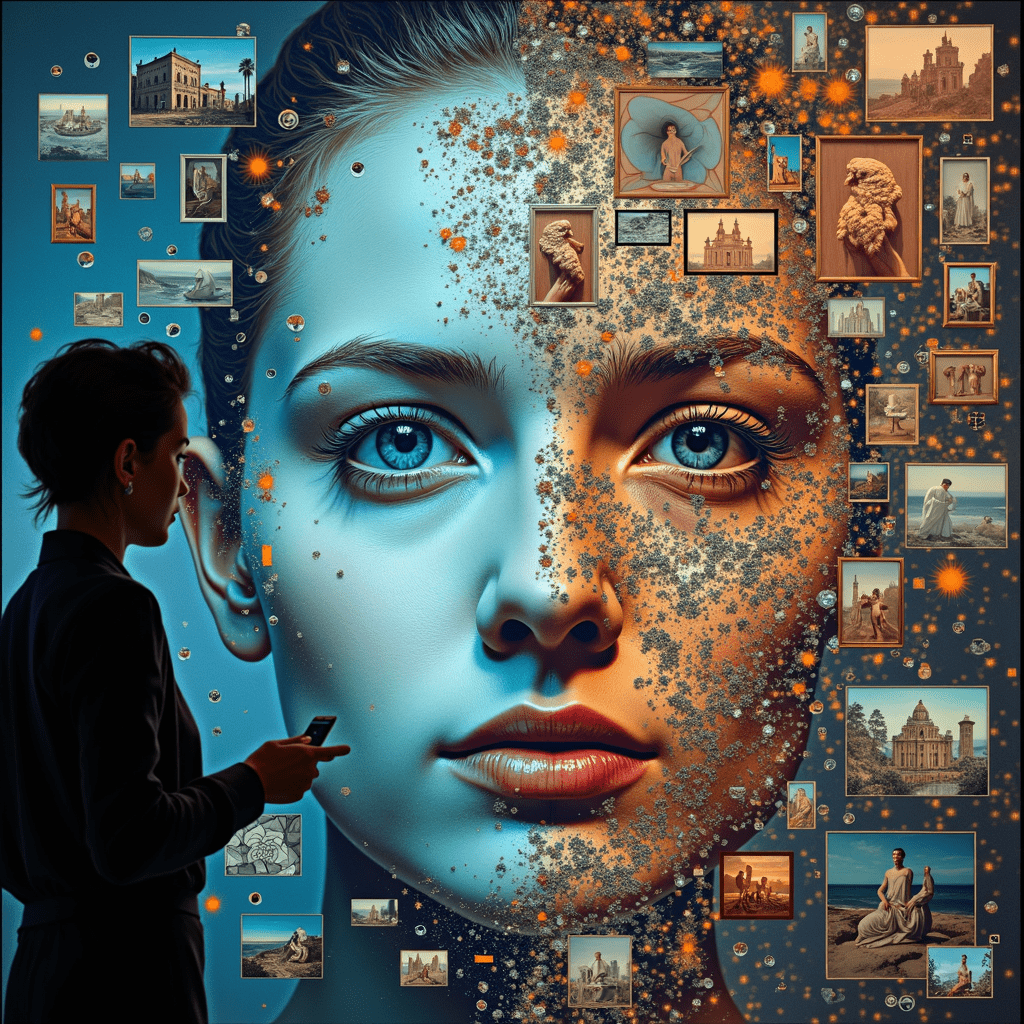
Emily’s Transformation Through AI
Emily was tired of the same old scenes. She used DeepDream to make her sketches weird and wonderful. It made 48 different versions in just a minute. One version, with a twisted oak, was her starting point.
Her work changed:
| Traditional Approach | AI-Enhanced Method |
|---|---|
| 3-5 sketches weekly | 200+ concept options |
| Manual color testing | Algorithmic palette matching |
| Local gallery feedback | Global style trend analysis |
Practical Steps to Blend Output With Personal Style
Emily’s success came from blending AI with her style:
- Chose base images that showed her unique texture
- Worked on organic shapes and light patterns
- Added real brushstrokes to digital art
“The tools didn’t replace my voice—they amplified it. I spent less time brainstorming, more time perfecting.”
Her art sold out in two days. She learned to use tech’s speed but keep her art true to herself. Like historical recreations, her work mixed data with human touch.
Addressing Challenges and Ethical Considerations
How do you keep designs human when algorithms help with every detail? This balance between speed and authenticity is key in today’s creative world. Studies show 67% of people can tell if art is made by a machine. And 82% prefer brands that value human touch.

Preserving Artistic Authenticity
Your team’s ability to add soul to designs is key. Yale’s Digital Ethics Center found that using tools as supplements makes art more emotionally rich. A perfume brand, for example, sketched bottle designs by hand before using algorithms to test them.
Key strategies:
- Set clear limits for machine input in the beginning
- Use data to enhance—not control—color and texture choices
- Regularly check designs for unique human touches
Avoiding Overreliance Pitfalls
Too much tech can make skills fade. A 2023 Adobe survey found designers who only used automated tools had weaker typography skills in six months. It’s important to find a balance, like a chef who uses processors but also knows how to use knives.
Follow these guardrails:
- Limit AI suggestions to 30% of your work
- Keep sketchbooks for analog work
- Switch team members to analog projects every quarter
As ethical issues in tech art grow, knowing when to use tech is key. People want connection, not perfection. Your work shines when machines do the routine tasks, letting your team create something truly special.
The Future of Innovation in Brand Design
Tomorrow’s brands will speak directly to their audience. They will use real-time data to predict what people want, not just react to it. The next step is creating designs that are both personal and global.
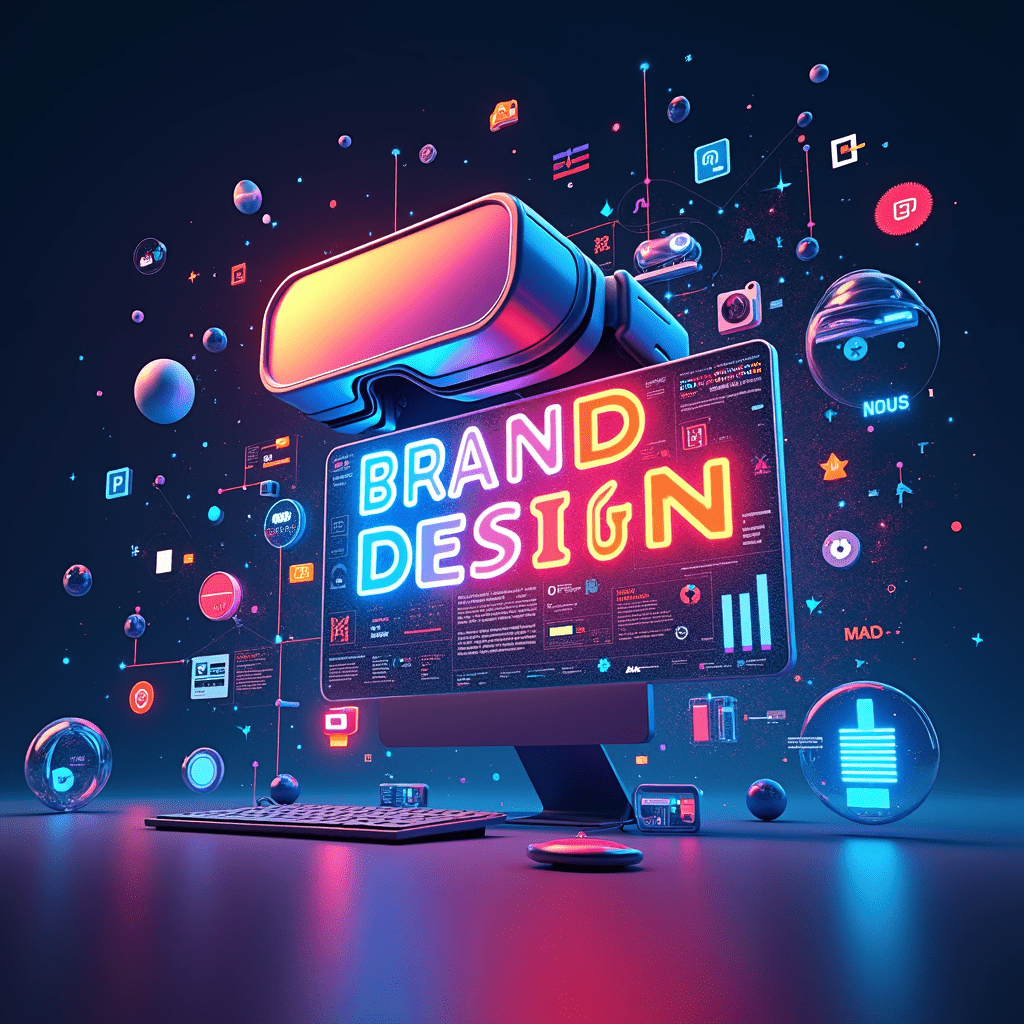
Emerging Trends in AI Integration
Hyper-personalization is changing how we design. Imagine packaging that changes based on the weather or websites that adjust to your mood. These changes happen through live feedback loops, where every action shapes the next.
Global style fusion is also growing fast. Platforms now mix design trends from around the world. For example, a sportswear brand created sneakers that reflect local cultures but keep the brand’s essence.
Language is playing a big role too. Tools can understand slang and idioms, helping brands speak to every market. A Tokyo marketer said:
“Machines catch nuances even bilingual humans miss—but they can’t replicate the warmth of a handwritten tagline.”
To stay ahead, use technology as a cultural bridge. Update your tools often and test new systems. The goal is to create designs that evolve with your audience’s needs, keeping the human touch.
Human Expertise as the Bedrock of Creative Output
Your brand’s best designs come from combining data and human insight. Even the smartest tools can’t replace the spark that makes designs memorable. This mix of instinct and analysis makes visuals stand out.
The Vital Role of Data and Intuition
Science finds patterns, but your mind gives them meaning. Research from Stanford’s Design School found teams using both data and instinct create 73% more effective campaigns. A beverage company increased recall by using survey data and an art director’s color sense.
| Aspect | Human Contribution | Data Contribution |
|---|---|---|
| Idea Formation | Unique perspective | Trend forecasts |
| Refinement | Emotional resonance | Engagement metrics |
| Execution | Style expression | Platform optimization |
Fostering a Collaborative Creative Environment
Great expression happens when people and tools work together. A New York studio lets designers sketch first, then uses algorithms to test designs. Lead artist Mara Vlasic said:
“Our best work happens when technology handles the ‘what’—we focus on the ‘why’. A machine can suggest 100 layouts, but only humans know which one tells our client’s story.”
Build spaces where your team’s skills lead digital tools. Have “analog Fridays” for sketching without screens. Use monthly data reviews to spot trends. Your perspective is what turns information into relatable branding.
Conclusion
Your brand’s next big thing might come from an unexpected partnership. Combining human intuition with machine precision creates visuals that resonate and perform well. Think of Netflix’s dynamic thumbnails or Spotify’s personalized playlists as examples of technologies boosting human ideas.
Remember the beverage company that boosted sales by 34% with data-driven packaging? Or the painter who turned a creative block into a sold-out collection? These results show that blending expertise with innovation can break boundaries.
This approach isn’t about replacing your team’s magic—it’s about amplifying it. By letting algorithms handle routine tasks, you can focus on what makes your brand unique. The key point? Machines are great at patterns, but people are better at making meaning.
Think of these tools as partners in your creative journey. Try one technology this quarter, like improving color palettes or understanding customer speech. The future is for brands that mix data with storytelling. Begin your next project today.
FAQ
How does artificial intelligence impact originality in brand design?
AI tools look at huge amounts of data to find patterns we might not see. They come up with new ideas, but humans must judge and refine them. It’s like having a brainstorming buddy that speeds up the process without taking over your ideas.
What should I prioritize when selecting tech tools for creative work?
Choose tools like Adobe Sensei or Canva’s Magic Design that fit your workflow. Look for customization options so your input guides the tool. See how well they work with what you already do.
Can brands maintain authenticity while using automated design solutions?
Yes, by seeing algorithms as helpers, not replacements. For example, Patagonia uses climate data in campaigns but keeps its activist voice strong. Being true to your values means adapting machine-made ideas to fit your brand.
What emerging trends blend human creativity with machine learning?
Tools like Figma’s AI features and DALL·E 3 are becoming popular. They handle tasks like resizing graphics, freeing up time for creative work and emotional storytelling.
How do professionals balance automation with personal creative input?
Use algorithms for research or drafts, then add your touch. Grammy winner Alex Da Kid mixes AI beats with live music, showing tech can enhance, not replace, human creativity.
Are there ethical risks in using algorithms for branding projects?
Yes, there are risks like bias in data and copyright issues. Always check tools for fairness and legal compliance. Being open with your audience helps build trust when using technology.
What steps help merge machine output with a unique visual style?
Begin with mood boards or style guides to train tools. Studio DIA’s work shows how using brand colors and fonts in Midjourney can create cohesive drafts. Keep refining based on feedback, always focusing on your audience’s feelings.
